Top 15+ Succession Planning Tools and Software for 2025
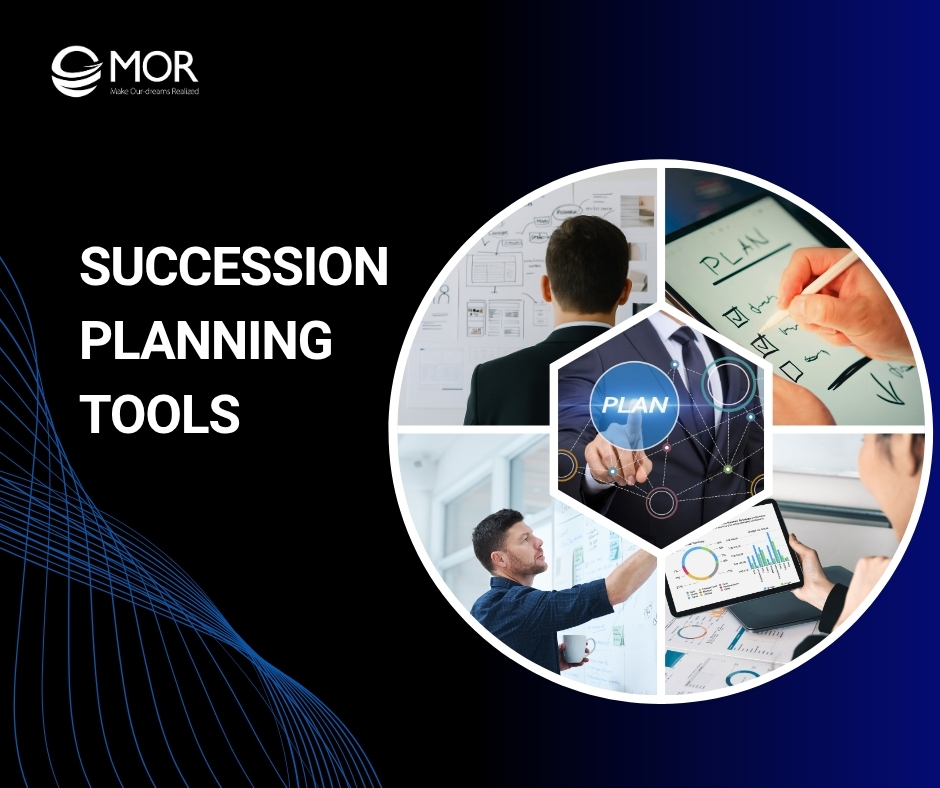
Finding and preparing future leaders isn’t easy, especially when key roles suddenly become vacant. That’s where succession planning tools help, they give organizations a clear, data-driven way to identify, train, and promote the right talent before gaps appear. This MOR Software’s guide will break down the top options in 2025, helping you choose the right fit for your team’s growth and long-term stability.
What Are Succession Planning Tools?
Succession planning tools are digital solutions, templates, or platforms that help companies discover, train, and prepare future leaders for key roles. In a SHRM survey, only 21% of HR professionals said their organization had a formal succession plan in place, while 24% had an informal one. This shows why these tools are important.
These HRM models make it easier for HR teams to manage transitions by identifying high-potential employees and guiding them through structured development programs. The pressure is growing at the top, with 2024 recording 202 CEO exits worldwide, a 9% increase from the previous year, reminding organizations how important it is to prepare before key leaders leave.
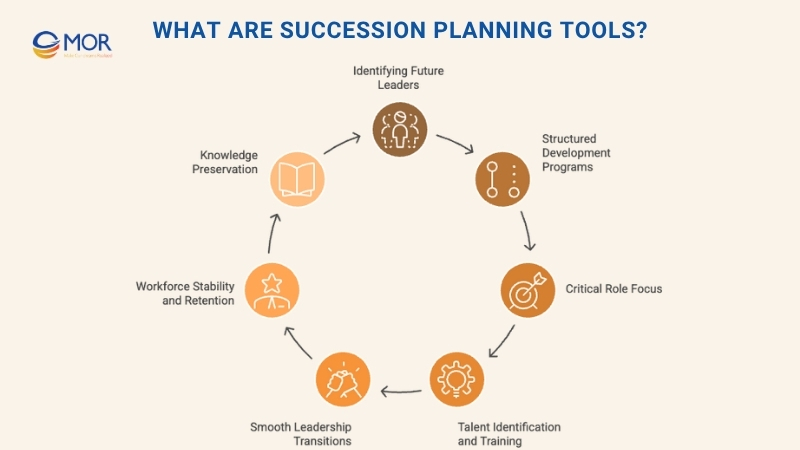
A succession planning tool supports organizations in shaping a clear succession planning process built around three core principles:
- Focus on critical positions: Only roles that directly affect business continuity are prioritized for succession planning. Boards are increasingly turning to their own talent pipelines to maintain stability, and in 2024, Korn Ferry found that most new leaders came from internal promotions in 8 out of 10 countries they analyzed.
- Identify and develop talent: The goal is to find top performers and give them the training and mentoring needed to take on leadership roles when the time comes. This kind of investment helps keep people longer, as DDI’s recent research shows that high-potential employees are about 3.7 times more likely to leave if they don’t see clear chances to grow.
- Guarantee smooth transitions: When a leader leaves, the organization already has capable successors ready to step in without disrupting operations. Recent research from Harvard Business Review shows that managers promoted from within generally perform better than those hired externally, highlighting the importance of preparing successors early.
Combining assessment, tracking, and forecasting, these tools for succession planning strengthen long-term workforce stability. They also form a key part of any HR succession planning strategy, helping businesses protect institutional knowledge and maintain consistent performance during leadership changes. Along with ensuring continuity, consistent planning and continuous performance management can also reduce disengagement costs, which McKinsey estimates can quietly take up around 4% of a large company’s total payroll.
Key Benefits Of Using Succession Planning Tools
It’s difficult to overstate how important succession planning tools are for any organization’s long-term health. In companies with a multigenerational workforce, especially where senior leaders are nearing retirement, these tools create stability and protect institutional knowledge. By planning early, businesses avoid sudden leadership gaps and keep operations running smoothly when transitions happen.
Strong succession software ensures business continuity by preparing new leaders before key roles become vacant. It also builds confidence among employees, stakeholders, and customers that the organization is well-prepared for the future. The result is a culture that values readiness, transparency, and growth across all levels.
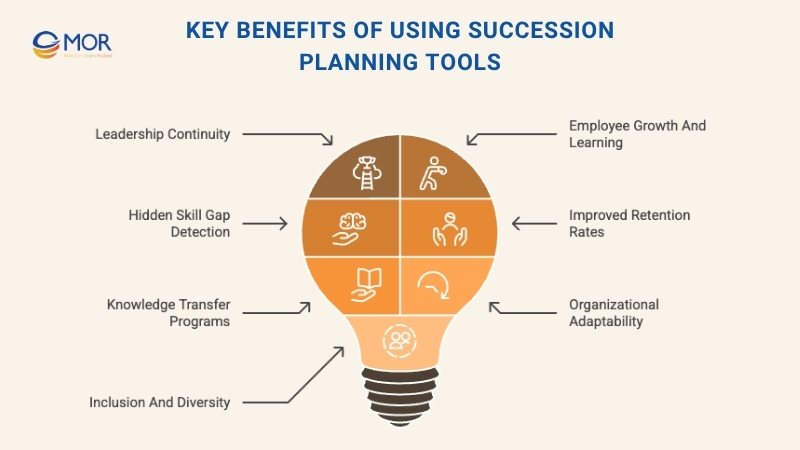
Here’s how effective succession planning tools for managers and HR teams contribute to organizational success:
- Protects leadership continuity: Executives may retire, accept promotions, or leave unexpectedly. With proactive planning, companies already have trained successors ready to step in. This minimizes disruption to operations, stabilizes workflows, and maintains stakeholder trust during leadership changes.
- Drives growth and learning: Employees can see a clear path forward. With the right guidance, they develop the skills and confidence to take on future roles. These programs strengthen engagement and satisfaction, ensuring that staff feel valued and motivated to grow within the company.
- Reveals hidden skill gaps: Regular reviews using talent assessment tools for succession planning help pinpoint weaknesses in your workforce or workflows. With these insights, human resource development teams can build targeted upskilling and reskilling programs aligned with business goals and the company’s roadmap, ensuring future capabilities match organizational needs.
- Improves retention rates: A 2022 SIGMA study found that more than one in five employees left their jobs because they saw better growth opportunities elsewhere. Effective succession planning tools prevent this by showing employees that their careers have long-term potential within the company, improving retention and reducing turnover costs.
- Preserves critical knowledge: Through mentoring, coaching, and structured knowledge-sharing programs, experienced leaders can pass their expertise to successors. These tools of succession planning help safeguard critical information and foster a culture of continuous learning and collaboration.
- Strengthens adaptability: Every strong succession planning matrix involves forward thinking. Teams can anticipate market shifts, skill needs, and leadership gaps before they occur. By maintaining a pool of ready successors, organizations stay adaptable and can move quickly when change arises.
- Promotes inclusion and diversity: Many companies still struggle to diversify their senior leadership teams. Integrating inclusivity goals into your succession planning framework ensures that underrepresented talent isn’t overlooked. This creates fairer opportunities and supports stronger, more innovative leadership pipelines.
In short, strategic use of succession planning tools keeps organizations agile, inclusive, and future-focused, essential qualities for thriving in 2025 and beyond.
Top 18 Succession Planning Tools And Software
Succession planning tools come in many forms, from simple spreadsheets to advanced cloud-based systems. Some offer quick templates for mapping successors, while others include AI analytics tools, talent tracking, and built-in development programs. The best choice depends on your company’s size, structure, and long-term goals.
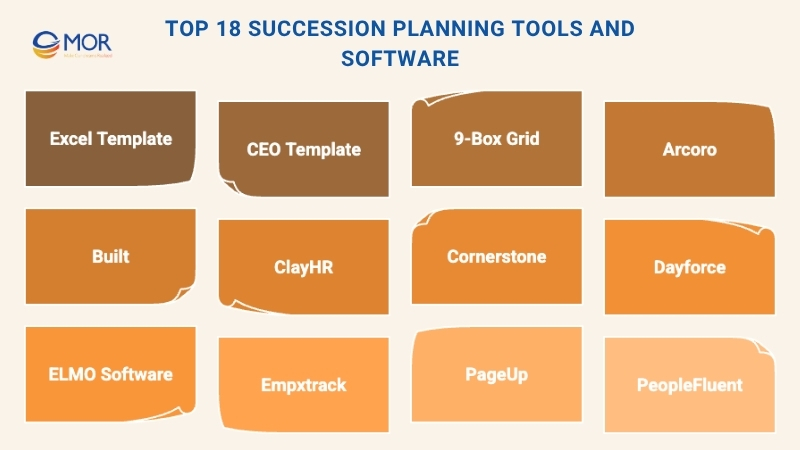
We’ll begin with practical templates before moving on to full-featured succession software designed for modern enterprises.
1. Excel Succession Planning Template
For small businesses or teams just starting with tools for succession planning, a structured Excel template is a reliable option. It creates a clear overview of leadership roles, potential successors, and readiness levels without the need for complex integrations.
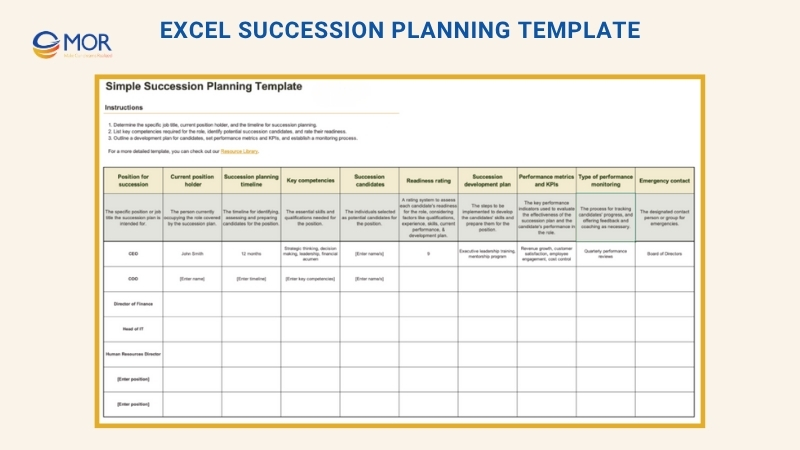
A basic template typically includes:
- Position under review
- Current role holder’s name
- Target date for replacement
- Key competencies for the position
- List of potential successors
- Readiness score or ranking
- Development plan summary for each candidate
- Progress indicators and KPIs for measuring advancement
- Update frequency (monthly or quarterly reviews)
- Assigned supervisor or HR contact for sudden vacancies
This kind of succession planning tools template is simple, flexible, and perfect for organizations in the early phase of building their succession planning process. It sets the foundation for structured planning before moving to more advanced systems.
2. CEO Succession Planning Template
A CEO succession planning template acts as a strategic guide for the board and executive teams to secure leadership continuity at the highest level. It structures how organizations identify, assess, and prepare candidates capable of stepping into the CEO role when the time comes.
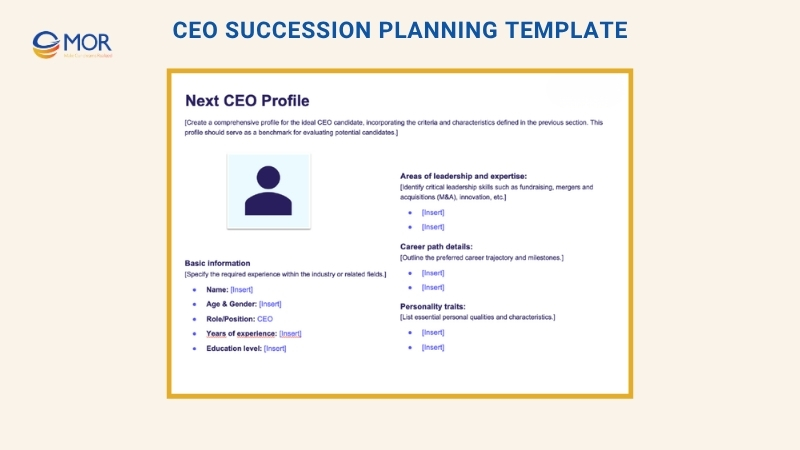
This succession planning tool defines the ideal leadership profile based on company strategy, market outlook, and long-term growth plans. It allows boards to evaluate both internal and external candidates against criteria like experience, vision, leadership style, and cultural fit. Each candidate’s readiness can then be ranked according to defined milestones and performance indicators.
Clear and organized, this template aligns all decision-makers on expectations, timelines, and evaluation standards. It’s an essential part of best practices in succession planning, helping organizations transition smoothly while maintaining investor, employee, and stakeholder confidence.
3. 9-Box Grid Tool
The 9-box grid is one of the most widely used succession planning tools for employees, offering a clear visual way to assess and compare talent. It maps individuals based on two dimensions, their current performance and their future potential, to help identify which employees are most prepared to grow into leadership roles.
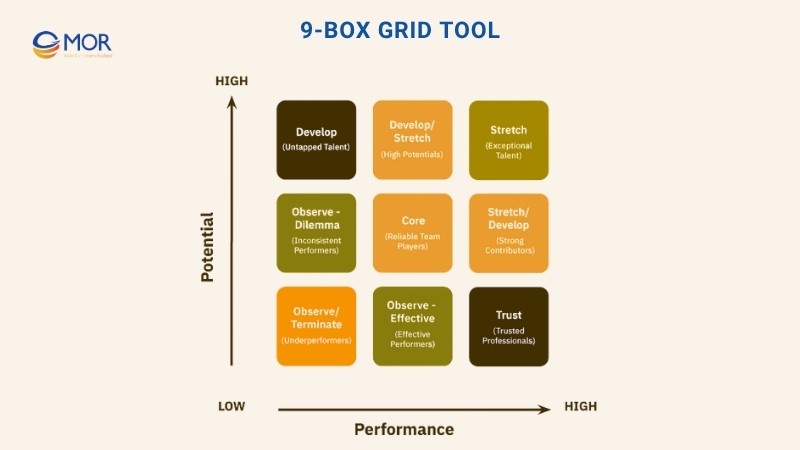
This succession planning chart highlights “high-potential, high-performing” individuals who can drive future success. It also helps HR teams and managers understand which employees need further development or coaching to reach the next level.
Using a 9-box grid gives organizations a structured, data-backed view of readiness across departments. By placing employees into defined talent categories, you build a stronger leadership pipeline and make smarter decisions when planning for future vacancies.
>>> Looking to upgrade how your team works? HRM software development helps companies automate hiring, training, and employee management, all tailored to your workflows.
4. Arcoro
Arcoro is an HR platform tailored for industries like construction, manufacturing, and public services. It simplifies workforce management through tools that track performance, training, and employee growth in one system.
What makes Arcoro stand out is its integrated succession planning matrix, which allows companies to evaluate leadership readiness through visual 9-box grids and detailed scorecards. Managers can compare performance, assess competencies, and review development progress across departments.
This approach turns workforce data into actionable insights, helping businesses identify rising talent early and strengthen internal mobility through well-structured succession planning tools for managers.
5. Built
Built is a modern succession planning tool designed to keep leadership pipelines accurate, current, and easy to manage. It automates updates, sends timely alerts, and ensures that no critical position is left without a ready successor.
What sets Built apart is its integration with existing HR systems. When used alongside a company’s HRIS, every change in staffing, whether a promotion, transfer, or exit, is instantly reflected in the succession plan. This automation saves time and eliminates manual tracking.
The platform also supports real-time collaboration, giving managers and decision-makers shared access to live data. With these features, Built makes the succession planning process more transparent, agile, and dependable.
6. ClayHR
ClayHR is a cloud-based HRM management software built for medium and large enterprises that want a unified system for the entire employee journey. It covers everything from onboarding and performance tracking to engagement and retention, giving HR teams complete visibility into workforce development.
What sets ClayHR apart is its AI-powered succession planning software, designed to identify and nurture future leaders. Its standout feature, Ask HR, acts as a smart assistant that helps employees approaching retirement or transition record key knowledge, upload documents, and share valuable insights.
This built-in knowledge-sharing capability supports smoother transitions and better-prepared successors, making ClayHR one of the most practical tools of succession planning for companies focused on leadership continuity and knowledge preservation.
7. Cornerstone OnDemand
Cornerstone OnDemand is a cloud-based talent management platform that supports learning, performance, and career development in one place. Its succession planning tools help organizations strengthen leadership pipelines and minimize the risks and costs of talent gaps.
What makes Cornerstone stand out is its proactive approach to building future-ready teams. The platform enables HR leaders to spot skill shortages, track potential successors, and design personalized development paths to close those gaps.
By combining data-driven insights with continuous learning, Cornerstone helps companies build lasting bench strength and keep critical roles covered, a proven approach for sustainable HR succession planning.
8. Dayforce
Dayforce is an all-in-one people management platform that unifies HR, payslip, benefits, and workforce planning. Its integrated succession planning tools help organizations identify, develop, and retain top performers through a single, connected system.
A standout feature of Dayforce is its promotion readiness tracking. This function lets HR teams see exactly where each employee stands on their development path, making it easier to plan promotions and career moves with confidence.
By giving leaders real-time visibility into readiness levels and growth progress, Dayforce helps companies strengthen their internal pipelines, keep high performers engaged, and support fair advancement opportunities within their succession planning framework.
9. ELMO Software
ELMO Software is a cloud-based HR platform widely used across Australia, New Zealand, and the UK. It brings together payroll, recruitment, onboarding, and performance management in a single, integrated system designed to simplify everyday HR operations.
Its succession planning tools allow HR teams to filter and group employees based on performance, readiness, criticality, and flight risk potential. This helps companies identify who is most prepared to take on key roles and where development is still needed.
Another advantage is scalability. ELMO adapts to an organization’s maturity level, growing alongside its workforce and structural needs. This flexibility makes it a reliable succession planning tool for companies aiming to stay organized and future-focused.
10. Empxtrack
Empxtrack is a complete HR platform that manages the full employee lifecycle, from hiring and onboarding to performance and retention. Its succession planning tools provide a structured way to identify leadership roles and pinpoint top-performing employees through 9- or 12-box talent grids.
What makes Empxtrack stand out is its flexibility. The system allows organizations to build multiple succession plans for each position, short-, medium-, and long-term, ensuring continuous coverage even as business needs change.
With options for collaboration and transparent tracking, Empxtrack helps HR teams and executives align around leadership goals, making it one of the most practical succession planning tools for employees and leadership teams alike.
11. PageUp Succession Planning Software
PageUp is a full-suite talent management platform that connects recruitment, machine learning, and performance into one seamless experience. Its succession planning tools are designed to help organizations understand their workforce better, reduce turnover risk, and prepare for future leadership needs.
A key differentiator is PageUp’s real-time calibration feature. Using an interactive 9-box grid, HR teams and leaders can review talent, assess readiness, and identify employees with both the skill and ambition to move into critical positions.
With ongoing reviews and live updates, PageUp gives companies the agility to plan ahead confidently, keeping leadership pipelines strong and aligned with long-term business goals within their succession planning chart.
12. PeopleFluent
PeopleFluent is a trusted provider of talent and learning solutions that helps businesses attract, develop, and retain their best people. Its succession planning tools deliver a complete and adaptable system that enables HR teams to make informed decisions about leadership continuity and workforce growth.
What sets PeopleFluent apart is its flexibility. The platform adjusts to each organization’s size and priorities. Large enterprises can focus on identifying leadership risks and building resilience at the top, while mid-sized businesses can emphasize mentoring and career development to strengthen internal growth.
With intuitive dashboards, performance analytics, and collaboration options, PeopleFluent provides everything needed to support a future-ready workforce within a modern succession planning framework.
13. Plum
Plum helps organizations match the right people with the right roles using a data-driven approach to hiring, development, and leadership planning. Its platform supports scalable strategic workforce planning and upskilling while keeping the employee experience at the center.
What makes Plum unique is its combination of AI technology and Industrial-Organizational Psychology. The system evaluates key traits like strategic thinking, adaptability, and problem-solving to identify future leaders early.
Blending science and automation, Plum gives HR teams the insights they need to fast-track talent growth, strengthen leadership pipelines, and build a more capable, future-ready team using data-backed succession planning tools templates.
14. SuccessionNow
SuccessionNow is a dedicated succession planning software platform built to simplify leadership transition and replacement for organizations of every size. It transforms a traditionally complex process into an easy, structured, and transparent workflow that supports long-term stability.
What makes SuccessionNow stand out is its foundation, it was created by industry experts with more than three decades of hands-on experience in leadership development and organizational planning. Their real-world expertise shapes every feature, ensuring the platform meets the practical needs of HR leaders managing change.
With its intuitive interface and expert-driven design, SuccessionNow brings both credibility and usability to modern succession planning tools, making it a trusted choice for businesses seeking reliable continuity.
15. SumTotal
SumTotal is a comprehensive talent management and machine learning model that helps organizations strengthen their workforce and plan for long-term leadership continuity. Its succession planning tools allow companies to identify skill and competency gaps, build future-ready talent pools, and align leadership planning with overall business strategy.
A unique highlight of SumTotal is its use of the n-box grid for visualizing team performance and potential. This feature provides leaders with a clear view of readiness levels across departments, making it easier to identify high-potential employees and model succession scenarios effectively.
Linking development plans to business goals, SumTotal supports smarter, data-driven succession software strategies that prepare companies for growth and change.
16. TalentGuard
TalentGuard delivers AI-powered workforce intelligence that helps organizations plan, develop, and retain their best talent. Its succession planning tools allow companies to identify critical positions, assess high-potential employees, and create personalized development paths that prepare future leaders.
A key advantage of TalentGuard is its flexibility in managing talent pools. Businesses can create an unlimited number of specialized pools and keep them continuously updated with real-time data on availability, skills, and performance.
This approach ensures every key role has a ready successor and that decision-makers always have access to current, data-driven insights. With its focus on automation and visibility, TalentGuard simplifies leadership planning across all levels of the organization’s succession planning matrix.
17. Qooper
Qooper is a mentorship and training platform used by businesses, universities, and associations to strengthen learning and development. Beyond its mentoring focus, Qooper also serves as an all-in-one solution for executing effective succession planning tools and programs.
What makes Qooper unique is its emphasis on real-world application. Instead of just mapping successors, it helps companies actively develop them through guided learning paths, mentorship programs, workshops, and peer discussions.
One standout feature is its intelligent matching algorithm, which pairs employees with the most suitable mentors based on goals, skills, and interests. This makes Qooper an engaging, people-first succession planning tool that turns leadership development into a continuous, interactive process.
18. Workzoom
Workzoom is an integrated HR, payroll, and workforce management platform that unifies all aspects of people management in one system. Its succession planning tools help businesses automate planning, track readiness, and maintain continuity across every level of the organization.
What sets Workzoom apart is its focus on making succession plans actionable. The platform brings these plans to life through three key elements: high visibility, detailed reporting, and consistent communication.
Giving leaders clear insights and regular updates, Workzoom encourages proactive leadership development and helps organizations stay committed to growing internal talent within a structured succession planning chart.
How To Choose The Right Succession Planning Tools?
Selecting the best succession planning tools depends on your organization’s structure, resources, and long-term vision. The right solution isn’t necessarily the most advanced or expensive, it’s the one that aligns with your culture, workflow, and leadership goals. Below are some essential points to guide your decision:
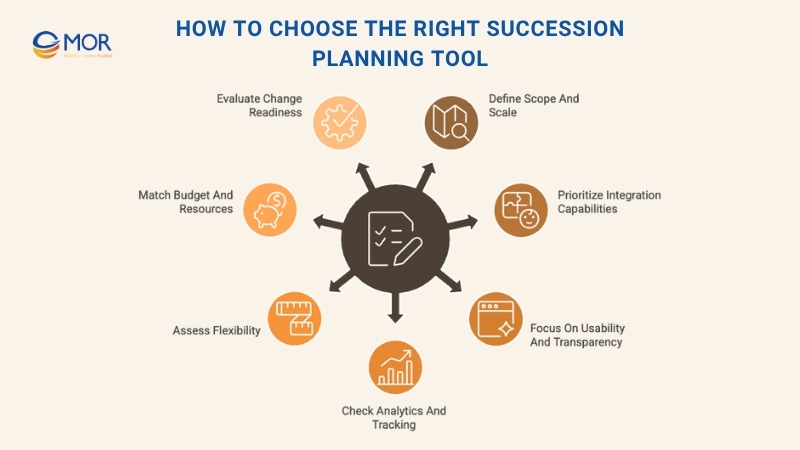
1. Define Your Scope And Scale
Clarify how extensive your planning needs to be. Smaller companies may focus on just a few essential positions, while larger enterprises might build tiered leadership pipelines for different departments. Choose a system that can evolve alongside your business, supporting both early-stage planning and long-term strategy.
2. Prioritize Integration Capabilities
A good succession planning tool should easily integrate with existing HR systems, including performance reviews, training platforms, and payroll software. Seamless integration reduces duplicate work, keeps records synchronized, and allows you to manage development programs from one unified dashboard.
These foundational steps help create a strong base for choosing the right succession planning tools for managers and ensuring they align with the organization’s growth and readiness objectives.
3. Focus On Usability And Transparency
Easy-to-use succession planning tools drive higher adoption across teams. Look for a clean, intuitive interface that lets HR and managers quickly view successors, monitor development plans, and assess leadership readiness at a glance. Transparency is equally vital, employees should understand their progress and position within the succession pipeline.
4. Check For Analytics And Readiness Tracking
Data is the foundation of smart succession planning tools for employees. The right platform provides visual dashboards that highlight skill gaps, readiness levels, and performance trends. Features like real-time analytics, readiness scoring, and progress tracking turn talent development into a measurable, data-driven process that supports long-term leadership success.
5. Assess Flexibility
Every organization approaches leadership differently, so flexibility is key. Choose succession planning tools that let you tailor competencies, career paths, and timelines to fit your structure. Customizable criteria and adaptable development plans ensure the system stays useful as your company grows and priorities shift.
6. Match Budget And Resources
For teams just starting with tools for succession planning, it’s smart to begin small. Use simple or low-cost templates to build a foundation, refine your process, and demonstrate early success. Once your program matures, you can move to enterprise-level software with advanced tracking and analytics to scale your succession planning process effectively.
7. Evaluate Change Readiness
Rolling out succession planning tools often requires shifting habits and expectations. If your organization is new to structured planning, begin with a pilot project in one team or department. Collect feedback, refine the process, and scale up gradually. The best systems support your current maturity level rather than complicate it.
In the end, selecting the right best tools for family business succession planning comes down to balance. Look for a solution that fits your culture, integrates smoothly with existing systems, and helps you build a sustainable leadership pipeline that grows with your organization.
Partner With MOR Software For Custom Succession Planning Tools
At MOR Software, we help businesses strengthen leadership continuity through tailor-made succession planning tools built to match their goals, structure, and culture. Instead of using generic templates, we design data-driven platforms that integrate seamlessly with your existing HR ecosystem, giving you full visibility into your leadership pipeline.
Our solutions combine AI outsourcing, automation, and predictive analytics to identify high-potential employees, assess readiness, and map career growth paths. With real-time dashboards, managers can track development progress, evaluate skill gaps, and plan internal mobility more effectively.
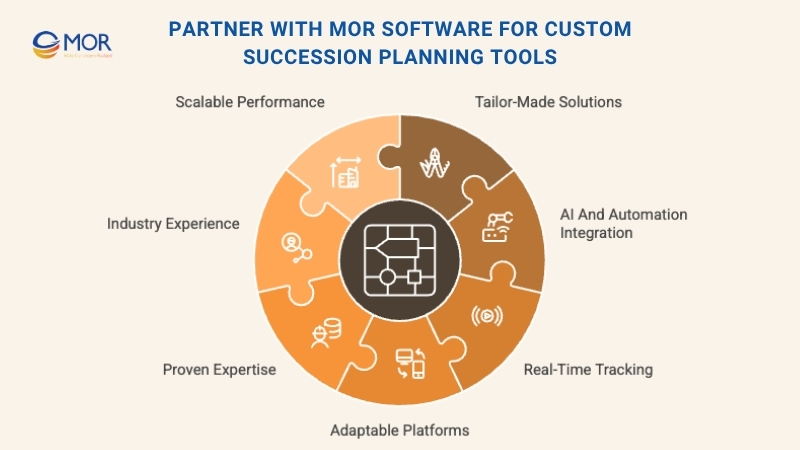
We understand that every organization’s workforce model is unique. That’s why our development team creates systems that adapt to your specific competencies, performance metrics, and role hierarchies. Whether you’re managing a small succession pool or a global leadership network, our platforms ensure smooth collaboration, secure data management, and scalable performance.
As a Top 10 Vietnam for software and a trusted Salesforce consulting and enterprise software partner, MOR Software JSC brings deep experience in HR technology, analytics, and cloud integration. Our specialists have delivered hundreds of successful digital transformation projects across industries like finance, healthcare, and manufacturing, helping companies prepare for the future of leadership with confidence.
Partner with MOR Software to turn your succession strategy into a smart, data-backed system that nurtures talent, supports agility, and drives sustainable business growth.
Contact us to discuss a custom solution for your organization.
Conclusion
Strong leadership doesn’t happen by chance. It’s the result of smart planning and the right succession planning tools. Investing in these solutions today helps your business stay ready for change, retain top talent, and build a stable leadership future. MOR Software designs custom platforms that align with your strategy and culture, turning leadership development into measurable success. Contact us to start building your next generation of leaders with confidence.
MOR SOFTWARE
Frequently Asked Questions (FAQs)
How do AI-powered succession planning tools improve leadership development?
AI enhances accuracy by analyzing skills, performance data, and learning trends. It can predict future role fit, identify gaps, and recommend personalized training paths.
Can succession planning tools integrate with HRIS and performance management systems?
Most modern tools integrate seamlessly with HRIS, payroll, and learning platforms. This ensures real-time updates and avoids duplicate data entry.
What are succession planning tools?
Succession planning tools help businesses identify and develop employees who can take over key roles when needed. They provide a structured approach to building leadership pipelines and maintaining operational stability.
Why do companies need succession planning tools?
They ensure leadership continuity and minimize disruptions when transitions occur. These tools also help organizations prepare future leaders, retain talent, and strengthen long-term workforce stability.
How do succession planning tools help identify future leaders in an organization?
These tools track performance, potential, and readiness levels across employees. With built-in analytics, they highlight who’s best suited for leadership development or promotion opportunities.
Which are the best succession planning tools for small businesses in 2025?
Smaller organizations can start with Excel templates or affordable cloud-based options like Built or Arcoro. These provide enough flexibility without the complexity of enterprise systems.
Are there any free succession planning templates or software available for startups?
Yes. Free Excel or Google Sheets templates are available for early-stage planning. Many HR software providers also offer free trials or limited versions to help startups get started.
What features should I look for when comparing succession planning tools?
Look for easy integration with HR systems, clear dashboards, analytics for readiness, and customization for competencies or roles. Scalability and user access controls are also key.
What’s the difference between a succession planning tool and a talent management system?
A succession planning tool focuses on leadership readiness and replacement strategies, while talent management systems handle broader HR processes like recruiting, onboarding, and performance.
How do companies use the 9-box grid in succession planning software?
The 9-box grid maps employees by performance and potential, making it easy to visualize who’s ready for advancement or needs further development.
Are cloud-based succession planning tools secure for managing employee data?
Yes. Most reputable tools follow international security standards like ISO 27001 or GDPR, ensuring encrypted data storage and access control.
How often should organizations update their succession plans using these tools?
It’s best to review and update plans at least once a year or whenever major leadership or structural changes occur. Regular updates keep data accurate and relevant.
What are some common mistakes to avoid when implementing succession planning tools?
Avoid relying only on performance data without considering potential, failing to engage managers, or skipping regular reviews. These can limit your pipeline’s effectiveness.
How do succession planning tools support diversity and inclusion in leadership roles?
By using data-driven insights, these tools reduce bias in candidate selection. They also make it easier to track representation goals and create equitable development opportunities.
What are the top-rated succession planning software platforms for enterprise use?
Popular enterprise choices include Cornerstone OnDemand, Dayforce, and PeopleFluent. They provide advanced analytics, multi-role planning, and scalable architecture.
How can I determine if my organization is ready to invest in advanced succession planning software?
If your company has multiple leadership levels, growing headcount, or lacks visibility into successor readiness, it’s time to adopt a formal succession planning system.
Rate this article
0
over 5.0 based on 0 reviews
Your rating on this news:
Name
*Email
*Write your comment
*Send your comment
1